 W
W19th Route Army was an army in the Republic of China led by General Cai Tingkai. It gained a good reputation among Chinese for fighting the Japanese in Shanghai in the January 28 Incident in 1932. In 1933-34 it was the main force in the Fuijan Rebellion, which opposed Chiang Kai-shek and unsuccessfully sought an alliance with the Chinese Communists in the Jiangxi Soviet.
 W
WThe Battle of Agua Carta, or the Battle of Lindo Lugar, was an engagement between the National Guard of Nicaragua and the rebels of Augusto César Sandino in 1932. It was fought near Mount Kilambe at the Agua Carta, a river in Sandino territory, as part of the American occupation of Nicaragua and a long lasting civil war.
 W
WAhmed Barzani revolt refers to the first of the major Barzani revolts and the third Kurdish nationalistic insurrection in modern Iraq. The revolt began in 1931, after Ahmed Barzani, one of the most prominent Kurdish leaders in southern Kurdistan, succeeded in unifying a number of other Kurdish tribes. The ambitious Kurdish leader enlisted a number of Kurdish leaders into the revolt, including his young brother Mustafa Barzani, who became one of the most notorious commanders during this revolt. The Barzani forces were eventually overpowered by the Iraqi Army with British support, forcing the leaders of Barzan to go underground.
 W
WThe Battle of Boquerón was a battle fought from September 7-29, 1932, between the Bolivian and Paraguayan armies in and around the stronghold of Boquerón. It was the first major battle of the Chaco War. The outpost (fortín) of Boquerón, among others, had been occupied by Bolivian troops since late July 1932 following instructions of president Daniel Salamanca, which led to the escalation of what began as a border conflict into a full-scale war.
 W
WThe Bonus Army was a group of 43,000 demonstrators – made up of 17,000 U.S. World War I veterans, together with their families and affiliated groups – who gathered in Washington, D.C. in mid-1932 to demand early cash redemption of their service certificates. Organizers called the demonstrators the "Bonus Expeditionary Force", to echo the name of World War I's American Expeditionary Forces, while the media referred to them as the "Bonus Army" or "Bonus Marchers". The demonstrators were led by Walter W. Waters, a former sergeant.
 W
WThe Chaco War was fought between Bolivia and Paraguay over control of the northern part of the Gran Chaco region of South America, which was thought to be rich in oil. It is also referred to as La Guerra de la Sed in literary circles, for being fought in the semi-arid Chaco. It was the bloodiest interstate military conflict fought in South America during the 20th century, between two of its poorest countries, both having previously lost territory to neighbors in 19th-century wars.
 W
WThe Constitutionalist Revolution of 1932 is the name given to the uprising of the population of the Brazilian state of São Paulo against the Brazilian Revolution of 1930 when Getúlio Vargas assumed the nation's Presidency; Vargas was supported by the people, the military and the political elites of Minas Gerais, Rio Grande do Sul and Paraíba. The movement grew out of local resentment from the fact that Vargas ruled by decree, unbound by a Constitution, in a provisional government. The 1930 Revolution also affected São Paulo by eroding the autonomy that states enjoyed during the term of the 1891 Constitution and preventing the inauguration of the governor of São Paulo Júlio Prestes in the Presidency of the Republic, while simultaneously overthrowing President Washington Luís, who was governor of São Paulo from 1920 to 1924. These events marked the end of the First Republic. Vargas appointed a northeasterner as governor of São Paulo.
 W
WThe Battle of El Sauce, or the Battle of Punta de Rieles or Punta Rieles, took place on the 26 December 1932 during the American occupation of Nicaragua of 1926–1933. It was the last major battle of the Sandino Rebellion of 1927–1933. The incident has its origins in Nicaraguan President José María Moncada's plan to commemorate the completion of the León-El Sauce railway on the 28 December 1932.
 W
WOn 9 November 1932, elements of the Swiss Army under Major Perret fired live rounds into a crowd of anti-fascist protesters in Plainpalais in Geneva, killing 13 and wounding 65.
 W
WThe Han–Liu War was a major military conflict in late 1932 between the private armies of Han Fuju and Liu Zhennian over Shandong. Even though Han as well as Liu were officially subordinates to the Chinese Nationalist government in Nanjing, both were effectively warlords with their own autonomous territories. Han Fuju controlled most of Shandong and had long desired to also capture the eastern part of the province, which was held by Liu. The tensions between the two eventually escalated, leading to a war that saw Han emerge victorious. He went on to rule Shandong unopposed for the next six years, while Liu was exiled to southern China.
 W
WThe January 28 incident or Shanghai incident was a conflict between the Republic of China and the Empire of Japan. It took place in the Shanghai International Settlement which was under international control. Japanese army officers, defying higher authorities, had provoked anti-Japanese demonstrations in the international District of Shanghai following the Japanese invasion of Manchuria. The Japanese government sent a sect of militant ultranationalist Japanese Buddhist priests belonging to the Nichiren sect to Shanghai. The monks were shouting anti-Chinese, pro-Japanese nationalist slogans in Shanghai, promoting Japanese rule over East Asia. In response, a Chinese mob formed killing one monk and injuring two. In response, the Japanese in Shanghai rioted and burned down a factory, killing two Chinese. Heavy fighting broke out, and China appealed with no success to the League of Nations. A truce was finally reached on May 5, calling for Japanese military withdrawal, and an end to Chinese boycotts of Japanese products. Internationally, the episode intensified opposition to Japan's aggression in Asia. The episode helped undermine civilian rule in Tokyo; Prime Minister Inukai Tsuyoshi was assassinated on May 15, 1932.
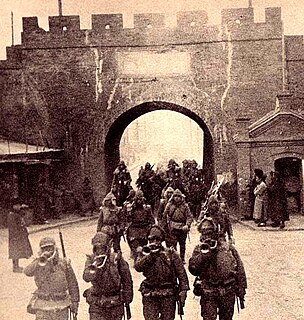 W
WThe Japanese invasion of Manchuria began on 18 September 1931, when the Kwantung Army of the Empire of Japan invaded Manchuria immediately following the Mukden Incident. At war’s end in February of 1932, the Japanese established the puppet state of Manchukuo. Their occupation lasted until the success of the Soviet Union and Mongolia on Manchurian Strategic Offensive Operation in mid-August of 1945.
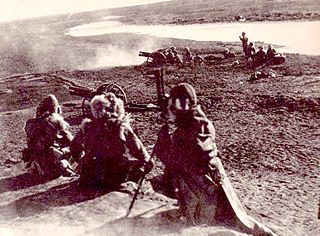 W
WThe Jinzhou Operation or Chinchow Operation was an operation in 1931 during the Japanese invasion of Manchuria, which was a preliminary, contributing factor to the outbreak of the Second Sino-Japanese War in 1937.
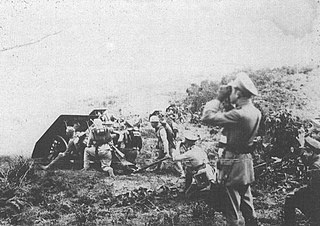 W
WThe Leticia Incident, also called the Leticia War or the Colombia–Peru War, was a short-lived armed conflict between Colombia and Peru over territory in the Amazon rainforest. In the end, they reached an agreement to divide the disputed area between them.
 W
WThe Mäntsälä rebellion was a failed coup attempt by the Lapua Movement to overthrow the Finnish government.
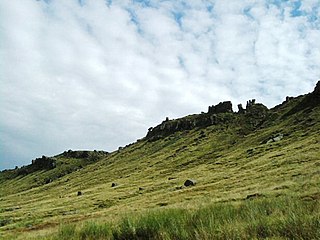 W
WThe mass trespass of Kinder Scout, also called the Kinder mass trespass, was an act of wilful trespass by ramblers and members of the Young Communist League. It was undertaken at Kinder Scout, in the Peak District of Derbyshire, England, on 24 April 1932, to highlight the fact that walkers in England and Wales were denied access to areas of open country. The trespass was largely organised by Benny Rothman, secretary of the British Workers' Sports Federation, in retaliation to the expulsion of the group from Bleaklow three weeks earlier.
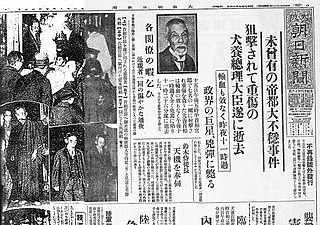 W
WThe May 15 Incident was an attempted coup d'état in the Empire of Japan, on May 15, 1932, launched by reactionary elements of the Imperial Japanese Navy, aided by cadets in the Imperial Japanese Army and civilian remnants of the ultra nationalist League of Blood. Prime Minister Inukai Tsuyoshi was assassinated by 11 young naval officers. The following trial and popular support of the Japanese population led to extremely light sentences for the assassins, strengthening the rising power of Japanese militarism and weakening democracy and the rule of law in the Empire of Japan.
 W
WThe Mukden Incident, or Manchurian Incident, was an event staged by Japanese military personnel as a pretext for the 1931 Japanese invasion of Manchuria.
 W
WThe Pacification of Manchukuo was a Japanese anti-insurgency campaign during the Second Sino-Japanese War to suppress any armed resistance to the newly established puppet state of Manchukuo from various anti-Japanese volunteer armies in occupied Manchuria and later the Communist Northeast Anti-Japanese United Army. The operations were carried out by the Imperial Japanese Kwantung Army and the collaborationist forces of the Manchukuo government from March 1932 until 1942, and resulted in a Japanese victory.
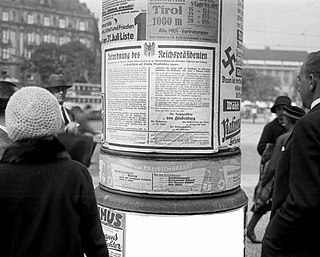 W
WThe Preußenschlag of 1932, also known in English as the coup in Prussia or the putsch in Prussia, was the takeover of the Free State of Prussia, the largest State of the German Reich, by Chancellor Franz von Papen, using an emergency decree issued by President Paul von Hindenburg under Article 48 of the Weimar Constitution on July 20, 1932.
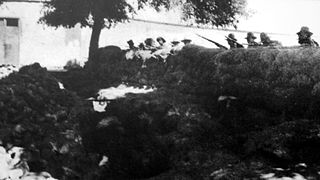 W
WRevolution of Trujillo was a social and political conflict in Peru which began in Trujillo city on July 6, 1932. It started with an uprising led by Manuel Barreto, against President Luis Miguel Sánchez Cerro
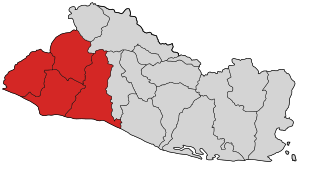 W
WLa Matanza was a peasant uprising that started on January 22, 1932 in the western departments of El Salvador and was suppressed by the government, then led by Maximiliano Hernández Martínez. The Salvadoran Army, being vastly superior, executed those who stood against it. The rebellion was a mixture of protest and insurrection which ended in ethnocide, claiming the lives of an estimated 10,000 to 40,000 peasants and other civilians, many of them Pipil people.
 W
WSanjurjada was a military coup staged in Spain on August 10, 1932. It was aimed at toppling the government but not necessarily at toppling the Republic. Following brief clashes it was easily suppressed in Madrid. Hardly any action was recorded elsewhere except Seville, where local rebel commander general José Sanjurjo took control for some 24 hours but acknowledged defeat when faced with resolute governmental response. Due to his brief success and attention given during following trials, the entire coup has been later named after him.
 W
WThe Siamese revolution of 1932 or Siamese coup d'état of 1932 was a coup d'état that occurred in Thailand (Siam) on 24 June 1932.
 W
WThe Sino-Tibetan War was a war that began in 1930 when the Tibetan Army under the 13th Dalai Lama invaded Xikang and Yushu in Qinghai in a dispute over monasteries. Ma clique warlord Ma Bufang secretly sent a telegram to Sichuan warlord Liu Wenhui and the leader of the Republic of China, Chiang Kai-shek, suggesting a joint attack on the Tibetan forces. Their armies rapidly overwhelmed and defeated the Tibetan Army.